Introduction
China’s re-opening process, global growth scenarios, EUR/USD outlook and major sectors.
- Following the loss of strict "zero cases" epidemic control and preventive procedures, China is currently experiencing the greatest Covid-19 mass outbreak ever recorded in the nation. The tight COVID limitations are now being lifted, which is accelerating China's economic recovery. According to economists, China can quickly recover from the Covid wave and continue to expand its economy in the short run. Concerns about Global inflation may arise as a result of China's re-opening mostly through commodity prices, although we currently expect only a minimal impact.
- Consensus expectations generally point to a downturn in 2023 Global GDP growth to 2.5-3.0%, which is thought to be the recessionary threshold for the global economy. Hence, a global recession is increasing in probability, according to most institutions. For instance, as stated in the IMF's growth report, global economic growth (excluding the EU region) will fall from 3.2% in 2022 to 2.6% in 2023, then 3.1% and 3.0% in 2024 and 2025, respectively.
- The Euro/Dollar parity increased by more than 14% since September as a result of the Fed and other central banks' announcements that they would slow the rate of interest rate hikes. We believe that the potential of a brief recession in the U.S. brought on by tight monetary policies in the first half of the year may worsen risk appetite, which might lead to a decline in the Euro/Dollar parity. However, we believe that by the end of the year, global inflation and macroeconomic uncertainty may be minimized and the advantages of holding dollar may be lost.
- The expectations for the Fed to slow down the interest rate hikes by 2023 and the reopening of China positively impacted the aviation and logistics sectors as natural gas and other commodities were suppressed due to global uncertainties and recession concerns. In regard to the climate crisis, we also favor the renewable energy sector's growth potential
Executive Summary
Based on historical trends, we evaluate that there may be up to a 10-15% loss potential in the S&P-500 index from the previous lows
- The FED's monetary tightening process, the ongoing effects of the Russia/Ukraine war (on commodities, natural gas prices in particular), and the deterioration in China's economic outlook have led to a severe increase in recession expectationsin the US and the world economy recently.
- However, although institutions such as the IMF, World Bank, and OECD have pointed to increased risk of recession, investors' expectation of a US recession has decreased significantly compared to last year, according to JPMorgan's model. The agency's trading model shows that a recession is currently priced in with a probability of less than 50% for the US economy . However, when we evaluate the current status of macro indicators that stood out as reliable recession indicators in the past, we think that the probability of a recession in 2023 (within the second or third quarter) is quite significant.
- Despite the slowdown in global growth, we expect the potential decline in oil prices to be limited due to ongoing geopolitical risks and OPEC's production cuts. Accordingly, we assume that the Brent oil price will fluctuate between $80-100/bbl throughout the year (we assume that price levels outside this range will not be sustainable). We also anticipate that gas cuts from Russia to Europe will continue and the TTF spot gas price will remain well above historical averages.
- We believe that the possibility of a recession may continue to be priced in positively for the stock market for a while more, as we expect the downtrend in CPI inflation to get more pronounced until 2Q22. Taking historical trends as a guide, if the U.S. economy is to enter a recession by say in 2Q23, we might expect further losses in the S&P-500 index. We evaluate that there may be up to a 10-15% loss potential in the S&P-500 index from the trough levels (~3,600) tested back in October.
Macroeconomic Overview
EUR/USD Outlook
EUR/USD had a strong fourth quarter for the euro. The pair tested its 20-year low in September 2022, when it traded below the 0.95 level. Following the statements made by the Fed that they would slow down the rate of interest rate hikes, the euro/dollar parity has risen by more than 14% since September.
Morgan Stanley currency strategists lowered their 2023 year-end forecast for the Dollar index (DXY) to 98 and stated that the Dollar will struggle against the euro. Despite the slowdown in growth in the US in the short term, depending on our expectation of deterioration in risk appetite, we predict that the Dollar index (DXY) may rise with the perception of a safe haven and the parity may turn down again (even below 1.0 level may be tested). Yet, as we expect the recession in the U.S. to be short-lived, we envisage that risk appetite would recover in the latter parts of the year (backed by a softening in the monetary policy guidance of advanced central banks, particularly the FED), leading to a resurgence in the EUR/USD rate back to 1.05-1.10 range, or probabaly above. Morgan Stanley revised its previous year-end euro/dollar forecast from 1.08 to 1.15. Bank of America strategists, on the other hand, announced that they expect the Euro to strengthen against the dollar in 2023 and the parity to strengthen towards its long-term balance to 1.10 at the end of 2023 and to 1.15 in 2024.
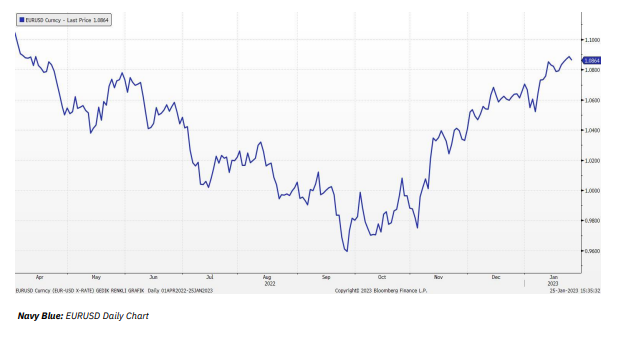
Finally, ING strategists have also revised their forecast for the end of 2023 fair EUR/USD to 1.15, and they believe the pair can remain strong with the expectation that US core inflation will fall sharply during the year.
China's normalization will have a positive impact on various sectors in 2023.
- At the end of 2022, Chinese authorities announced that as of January 8, 2023, there will be no need for quarantine for arriving passengers. Prior to this announcement, China also stopped publishing the daily number of cases after it stopped the Covid-19 PCR test application. The increase in the number of cases in the country since the U-turn in the restriction policy caused criticism to rise. China is facing the largest mass outbreak of Covid-19 ever seen in the country after abandoning strict epidemic control and prevention measures called "zero cases". It is estimated that more than 1 billion people (out of a population of 1.4 billion) will be diagnosed with Covid-19 in the winter months. On the other hand, the curfews and PCR tests implemented in China since the beginning of 2020 caused the economic growth rate in the country to slow down. As the end of China's strict Covid-19 restrictions accelerates the country's economic recovery, the country's GDP growth may accelerate towards 4.5-5.0% levels in the short term as lagged demand kicks in. Chinese policymakers recently signalled that regulatory pressure on tech companies would be eased, which may also be a supportive factor for short-term growth prospects. Nonetheless, we also anticipate that the growth potential of China will be severely suppressed in the medium-long term due to the ongoing problems in the housing market, the need to slow down credit growth, and weak domestic demand.
- Fed officials are voicing their concerns about China's rapid growth (especially over commodity prices) as a factor that could reverse efforts to ease inflationary pressures in the US economy. Louis Fed President James Bullard said that the normalization of China could cause inflation to accelerate again.
- China's normalization may actually pose inflationary pressure through commodity prices. On the other hand, the reopening of supply chains and the decline in freight prices may put downward pressure on inflation. Therefore, we presume that the effects of this process on global inflation and the economy may be limited.
- In conclusion, we are of opinion that the current conjuncture will have a positive impact on the commodities and aviation sector in 2023. Commodities such as petroleum, refined petroleum products, LNG, and soybeans could benefit from the demand of China. As a result of the normalization of China, we believe that the airline sector may return to its pre-Covid-19 performance in the first half of 2023. Recall that almost all previous forecastsindicated that recovery in the sector was not possible before 2024.
Global banks have raised their GDP forecasts for China.
- Morgan Stanley economists raised their GDP projections for 2023 to 5.7%, a 0.3% point increase according to the previous estimates. “The short-term pain of a rapid normalization will likely be offset by an earlier and stronger recovery” and “The market does not adequately appreciate the far-reaching consequences of normalization,” Morgan Stanley economists said. Other financial institutions have also raised their GDP forecastssince China abandoned harsh Covid-19 controls.
- Goldman Sachs economists raised their 2023 GDP forecast to 5.2% in December 2022. The US investment bank has not increased its forecast since then. However, the bank said in a research note released in January that it was ready for a further upswing in growth. The bank thinks the risk to these estimates could be upside if Covid diminishes relatively quickly, the risk to these forecasts could be upside as the peak in nationwide cases is likely behind,” the bank said.
- International Economic Institutions are making pessimistic forecasts according to investment banks. In December, the World Bank said it expects China's GDP growth to reach 4.3% in 2023 and had lowered its previous GDP growth forecast for the country from 4.5%. The World Bank said its forecast was exposed to significant risk, citing the possibility of renewed mobility restrictions and persistent stressin the real estate sector.
- In November 2022, the International Monetary Fund (IMF) predicted that China's GDP growth would be 4.4% in 2023. IMF Director Kristina Georgieova warned that in the first weeks of 2023, the new Covid-19 wave in China could pull the world economy down. Georgieova said that the impact of the epidemic on both Chinese growth and global growth will be negative.
Global Growth Scenarios: Most global Institutions stress the increased risk of a Global recession
- According to the IMF's "World Economy Overview" report published in October, economic growth in the world economy (excluding the EU region) is expected to decline from 3.2% in 2022 to 2.6% in 2023. According to the report, it is expected to remain at the recession border with 3.1% and 3.6%, respectively, in 2024 and 2025. The IMF stated that they would not make any changes in their growth forecasts to be published in January.
- In the OECD's "Overview of the World Economy" report released in November, the global economic growth rate is expected to decline to 2.2% in 2023 and rise to 2.7% in 2024.
- While the World Bank is discussing the possibility of a recession, it divides the issue into three scenarios as “Base”, “deceleration” and “hard recession”. In the “base” scenario, the growth rate in the world economy remains at the recession border with 2.4% and 3.0% in 2023 and 2024. In the “hard recession” scenario, growth rates decrease to 0.5% and 2.0%.
- Finally, the United Nations (UN) predicts that global economic growth will decline to 1.9% in 2023 due to the food and energy crisis caused by the Russia-Ukraine War, the continued impact of Covid-19, and high inflation. This rate was recorded as the lowest growth forecast among institutionsin recent years.
At this point, our expectation is that there will be a significant slowdown in the European economy, bringing 2023 growth to slightly negative, although mild weather conditions in winter months so far have reduced the possibility of an energy crisis. Regarding the U.S. economy, although the employment market remains fairly strong, many leading indicators that have proven reliable in predicting recessions in the past actually imply that the probability of the US economy entering a recession in 2023 is quite strong. These indicators may be summoned as the pace of the FED’s tightening, inversion of the yield curve, consumer confidence, dipping unemployment rate and Conference Board’s leading economic index (LEI). While we expect the US economy to enter a recession in 2023 (possibly by the end of 1Q23 or in 2Q23), we anticipate that it will be mild and short-lived. The Chinese economy, on the other hand, may display a positive outlook in the short term due to the reopening process. Developing countries can also be on the side of recovering the world economy in parallel with China, although we are not optimistic about China’s growth prospects over the longer term. Combining these, our global growth forecast for 2023 is at 1.9%.
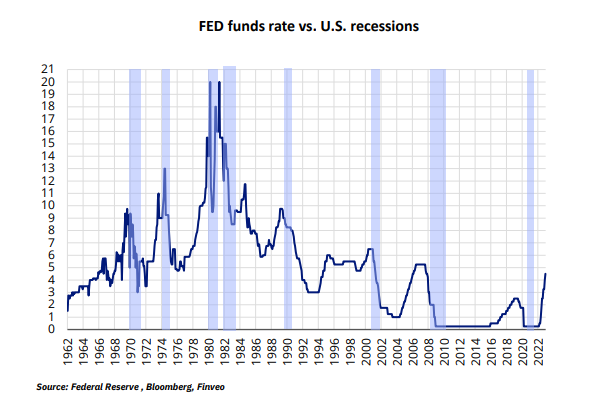
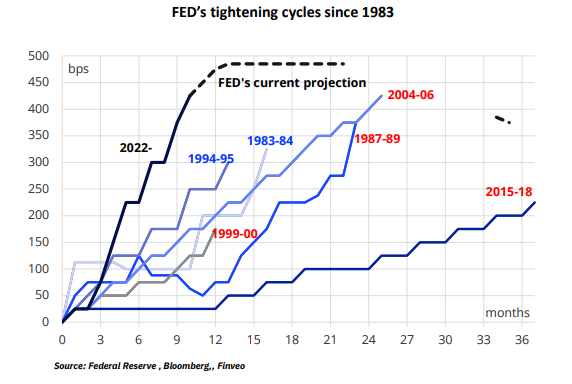
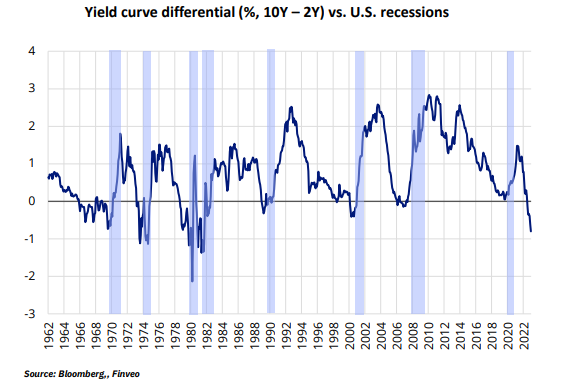
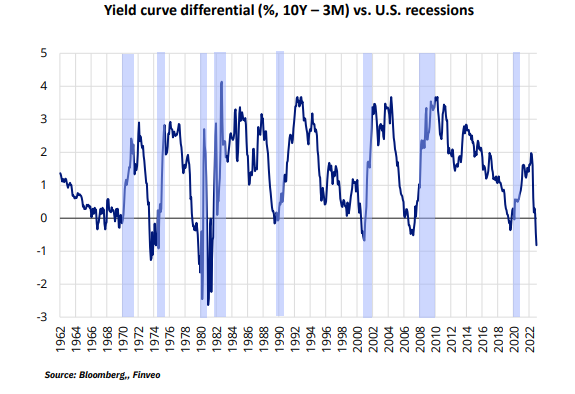
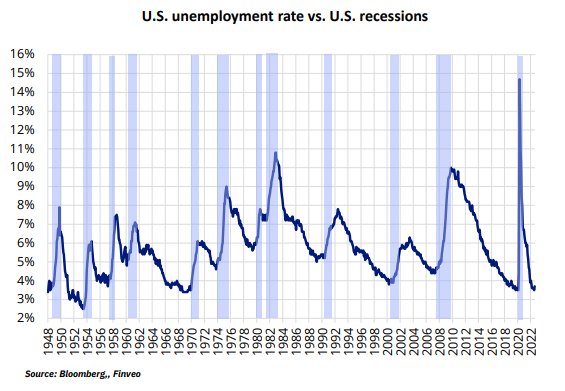
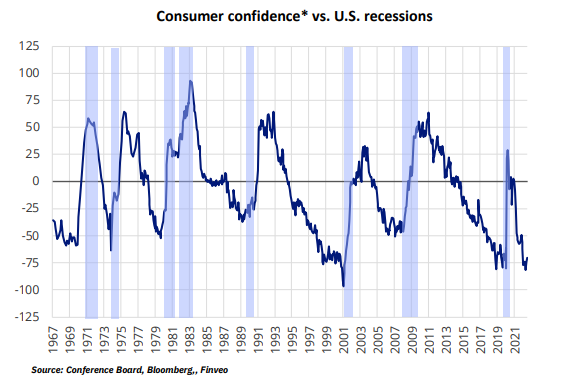
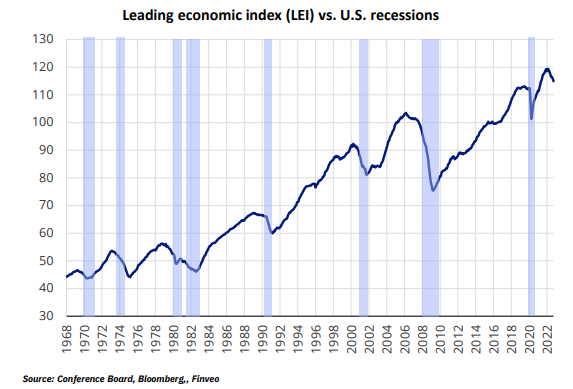
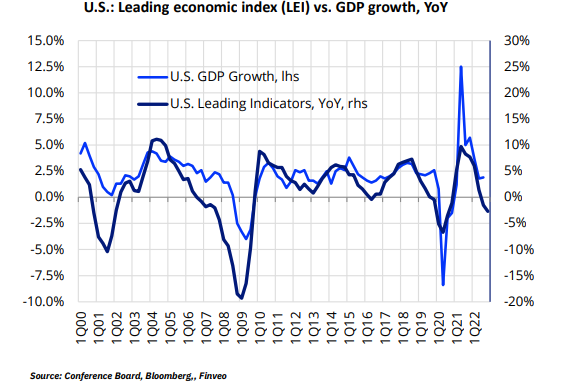
Commodities Overview
The World Bank’s “Commodity Markets Outlook” stresses that a potentially sharp slowdown in global growth would put pressure on commodity prices, although the energy markets are faced with a series of supply concerns.
We believe that commodity prices may remain suppressed as the slowdown in global growth intensifies, although various geopolitical issues pose upside risks. Despite a recent slowdown in commodities prices from peak levels, prices may remain well above historical averages, concerning these geopolitical risks.
According to the World Bank’s report, the energy commodity price index, which consists of oil, natural gas and coal, increased by 59.1% YoY in 2022, and is expected to decrease by 11.2% in 2023, but despite the said decrease, prices will be 75% above the average of the last 5 years. On the other hand, the same report reveals that the index consisting of non-energy commodity prices such as agricultural products, metals and minerals is expected to increase by 10.5% in 2022.
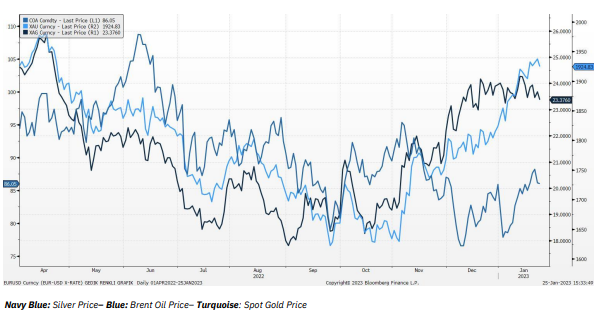
According to the same report, the price index for precious metals is predicted to fall by 4.2% in 2023 for the price of a gold ounce. Moreover, it's estimated that the price index for agricultural goods will fall by 4.5% this year.
Natural Gas
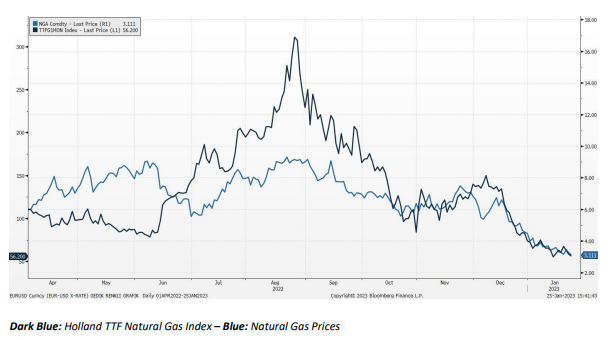
Due to Russia's reduced flow of natural gas to Europe and the contraction in demand, trade routes have changed and fuel constraints have been experienced in developing countries. New recordbreaking prices for natural gas in Europe and liquefied natural gas (LNG) in Asia lowered the demand for natural gas and led to the use of fuels such as coal and oil for electricity generation
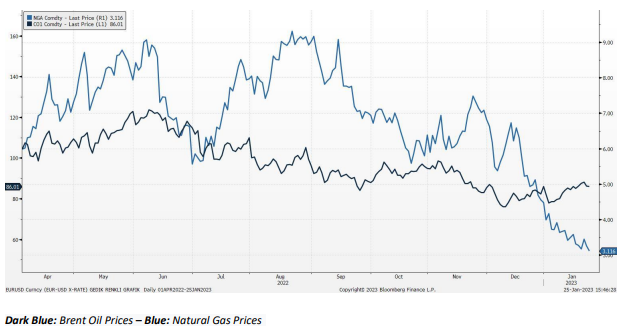
Europe has offset the cut in Russian gas by increasing imports of LNG and buying pipe gas from alternative sources with Norway. As a result, natural gas prices (Europe TTF), which had peaked at above €300/MWh, retreated to below €60/MWh, although these are still well above the historical levels of €10-20/MWh.
It is predicted that the global natural gas demand will grow by only 0.4% in 2023. Yet, we anticipate that the tightness in the global gas markets will continue in 2023 and thereafter, due to Russia’s negative stance on gas flow.
Shipping Sector
Covid-19, the Russia-Ukraine war, and high inflation caused disruptions in the logistics industry. On the other hand, the interruption in the supply of goods was another reason affecting the logistics industry. While no major capacity-related issues are expected in the next 3 years, it may take time for the global supply chain to return to its pre-Covid-19 performance
Consumer spending is showing signs of slowing down. A possible recession in the economy in 2023 may reduce freight prices. High freight costs were seen as a major contributor to rising US inflation, but may now help rein in inflation.
The container segment has seen a period of very high rates and profitability from the second half of 2020. High inflation affected consumer demand and reduced trade volumes, while reduced congestion at ports increased container transport capacity. While the line companies stopped the flights, this was not enough to prevent spot freight rates from returning to 'normal' levels. Global volumes in October fell 9.3% from 2021. Global container fleet capacity is expected to grow by 7.8% in 2023, with demand growth only reaching 3.5%. On the other hand, after several difficult years, the tanker market revived in 2022. The main catalyst for the market recovery has been the change in trade patterns due to sanctions on Russia's exports. The global tanker fleet may be prepared for a resilient 2023 despite economic uncertainties and the impending global recession.
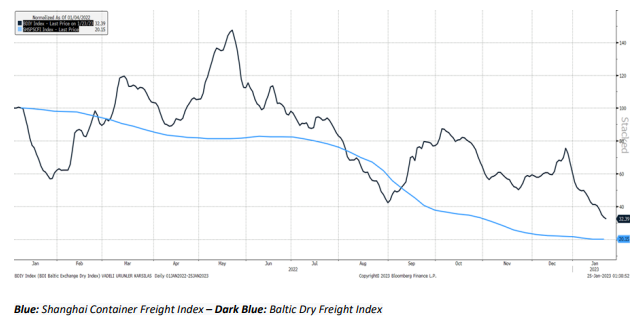
Finally, Russia's invasion of Ukraine brought energy security to the top of the global agenda. European countries are looking for alternative sources to replace Russian gas. In this period of increasing diversification of energy supply, LNG transportation can be an important area for energy transportation. Therefore, particularly biofuels and LNG may become popular in shipping in 2023. Although the volatility in the LNG energy market continues, gas prices are expected to improve in 2023, and there may be an increase in demand for ships with LNG capacity.
Aviation Sector
One of the sectors most affected by Covid-19 is the aviation sector. The industry gave signs of recovery as it approached the end of 2022. The sector saw a 70% recovery in passenger traffic, led by the recovery in Europe and North America last year. Now, with the recent reopening of China, the world's second-largest aviation market, global demand is gaining strength. In the upcoming period, interest in air travel may increase despite the strong dollar and inflationary pressures. Falling oil prices could also help increase margins.
Despite economic uncertainties, there are many reasons to be optimistic about 2023. Despite rising costs, stifled demand post-covid-19 could help maintain profitability as the strong growth trend continues. According to the International Air Transport Association (IATA); The global airline industry is expected to perform well in 2023, despite continued concerns about Covid-19 related financial losses, rising inflation, and cost pressures. IATA also expects airlines to report a net profit of $4.7 billion with a net profit margin of 0.6%. This is considered to be the airline's first profit since 2019 when net profit was $26.4 billion (or 3.1% net profit margin).
On the other hand, although the outlook for passenger services is largely positive, the global air cargo market may come under pressure in 2023, according to IATA. In addition, revenue may decrease by approximately $52 billion compared to 2022, to reach $149.4 billion.
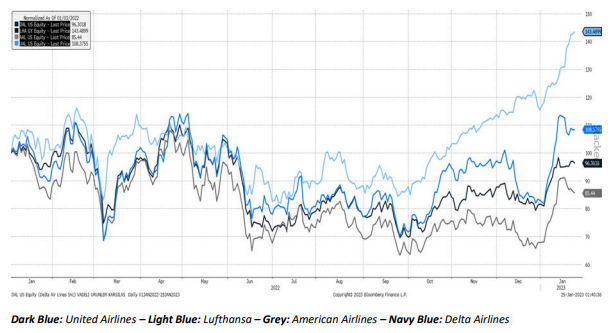
From another perspective, hybrid working models, which became widespread with the effect of the normalization process experienced after Covid-19, enable consumers to combine their travels with work as they are not limited to an office. While capacity rates have not yet returned to pre-pandemic levels, higher pricing helps balance. Expectations that the Fed will slow down the rate of increase in interest rates by 2023 in the coming period may have a positive impact on the aviation industry and stocks.
Renewable EnergySector
In 2022, renewable energy growth slowed its pace due to supply chain disruption, trade policy uncertainty, rising costs from inflation and increased interest rates. Many of these challenges are likely to continue in 2023, but industry growth is expected to accelerate due to strong demand and record-breaking clean energy incentives in the Inflation Reduction Act (IRA).
Transmission limitations in the industry and growth may continue to be hampered until capacity is significantly expanded, but emerging trends and ensuing opportunities can help the industry grow in 2023 and pave the way for faster growth in 2024. The United States added 5.7 gigawatts (GW) of utility-scale solar generation capacity and 7.5 GW of wind capacity in the first eight months of 2022, at 26% and 8%, respectively. The share of the US in electricity generation also increased from 21% to 23% in the same period.
At the annual meeting of the 2023 World Economic Forum (WEF) held in Davos, it was stated that clean technologies, renewable energy sources and decarbonization of the industry should be the answer to the current global crisis, while calling for stronger international cooperation in renewable energy supply chains.
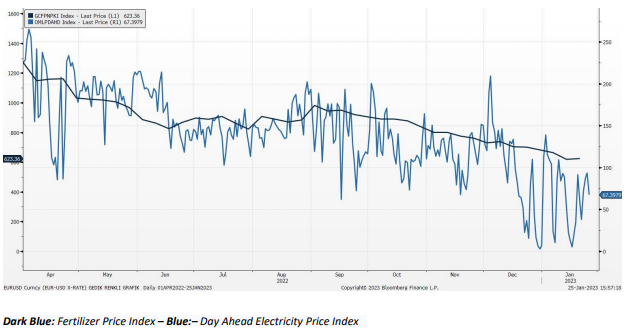
It is important that clean technologies and renewable energy sources can be a guarantor of peace and a catalyst for international cooperation in decarbonizing the economy. As a result, we predict that the renewable energy sector will grow as a result of the increase in global environmental awareness every year, the focus on clean technology industry investments in Europe and the USA, and the record incentives given.
Ready to start your trading journey? Create your account in minutes and start trading on MetaTrader 4 or 5.
Trade Now